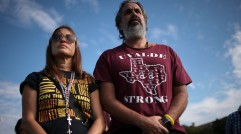1,700 Illegal Migrants in Panama Held in a Jungle Camp Due to COVID-19
The Panama authorities are currently holding roughly 1700 illegal migrants who are going to the United States in a jungle camp following the detection of several COVID-19 cases among them. This is according to an official source.
In addition, the migrants are kept in La Penita, a jungle close to the border of Colombia, in facilities developed and designed to accommodate just roughly 200 individuals.
It was also reported that around 17 migrants have also been detected with COVID-19 and are now out of the camp.
Even some Red Cross staff needed to leave the place, as well, to be held in quarantine since they were "in contact with a local police officer who perished because of COVID-19.
This is according to the International Federation of Red Cross for the Americas, Walter Cotte.
Illegal Migrants in Panama
Panama's National Migration Service (SNM) reported last year, the removal of more than 500 Nicaraguan migrants from Panama for the first half of 2019, almost one-fourth of the total population of foreigners which is 2,034, were deported to respective their home countries during this time.
Out of these over 500, or 531 to be exact, 86 the officials of the Panama immigration officially deported migrants, Panamanian immigration officials. Twelve migrants were banned from going back to their country, while the 433 left voluntarily went back to Nicaragua.
June represented the most number of migrant deportations of last year, with 24 formal removals of Nicaraguan nationals.
The data which came from SNM indicated that while the Nicaraguans composed of a significant share of permanent bans and deportations from Panama, the nation is ranked third, behind Colombians and Cubans.
Presidential Decree 269
Officials of the Panama immigration have used commonly used "voluntary return as their main approach for immigration enforcement." More so, since 2017, Panama has employed stricter policies for its immigration.
Relatively, Presidential Decree 269 has mandated that it is a must for any foreign tourist in Panama to depart after 90 days, which is shorter than the previous 180 days limit. This particular ruling was specially created to address the present influx not just of the Nicaraguans, but of Venezuelans and Colombians, as well.
Based on the official data of the SNM, 2018 saw more than "1,066 returns from Panama of the Nicaraguans," roughly a 33-percent decline from the 2017 figure from which around 1,603 were deported.
From 2010 to 2018, according to reports, there were more than 6,400 expulsions of Nicaraguans from this country, with 1,000 of such deportations taking place in the past four years. In the previous months, the neighbors of Panama, like Costa Rica, Mexico, and Guatemala, have encountered high volumes of migrants, too, at their borders.
COVID-19 in Panama
In Panama, where, as of this writing, there are 4,467 confirmed COVID-19 cases and 126 deaths, migrants are receiving treatments at "three temporary border posts" where the UNICEF, the Red Cross, and the government are providing them with food, water, and health care.
And, despite the threats, the border between Panama and Colombia has, for many years, become a
Despite the dangers, the border between Colombia and Panama has, for years, become a passageway for illegal immigrants, mainly those from Venezuela, Cuba, and Haiti. This has also turned to be the same pathway for distant countries like Nepal, Cameroon, Bangladesh, and Congo.
Check these out!
Subscribe to Latin Post!
Sign up for our free newsletter for the Latest coverage!












